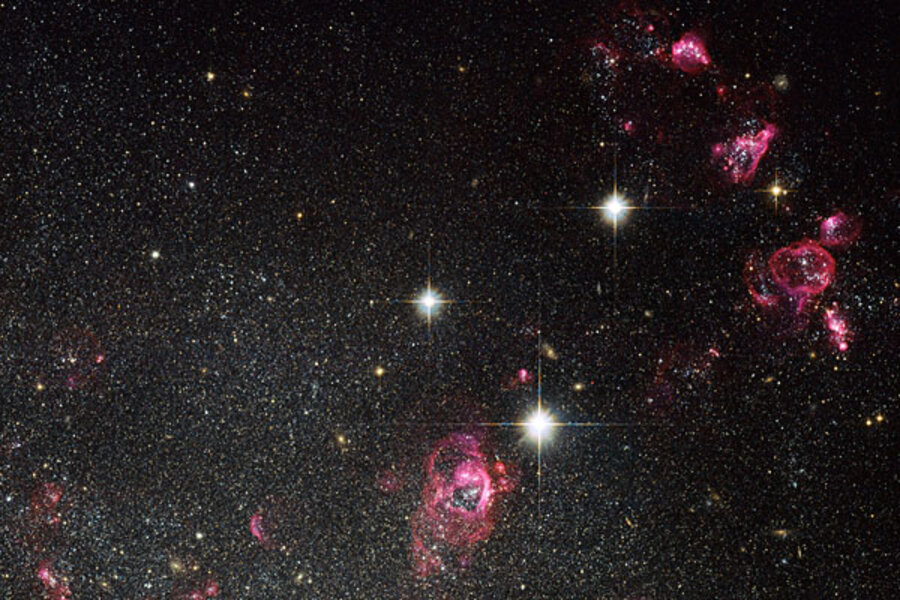Star factories: distant dwarf galaxies caught amid star-making frenzy
Loading...
When it comes to galaxies nurturing new stars in the early universe, the pint-sized can be surprisingly productive.
A team of astronomers has uncovered a population of dwarf galaxies some 9 billion to 10 billion light-years away that were producing stars at a furious pace.
The discovery presents a puzzle as scientists try to piece together the evolutionary history of dwarf galaxies, the most ubiquitous type of galaxy in the cosmos.
At the time these galaxies were blazing – some 3.7 billion to 4.7 billion years after the universe is estimated to have formed – dwarf galaxies represented about 2 percent of the star-formation activity underway in the universe, scientists believe. But they represented only about 0.1 percent of the overall amount mass available for star formation at the time.
The discrepancy implies an extraordinary level of activity.
At the rates these dwarf galaxies formed new stars, one of these would have doubled its population in about 10 million years, the wink of an eye on cosmic time scales. The Milky Way, by contrast, with about 100 times the mass of one of these dwarfs, would take about 10 billion years to double the number of stars it contains.
Typically, dwarf galaxies contain several billion stars, while the Milky Way is estimated to have between 200 billion to 400 billion. Many galaxies are even larger.
The startling star-formation rates stand in stark contrast to the production rates in dwarf galaxies near the Milky Way, which "are not really forming stars very fast, and neither is the Milky Way," says Steven Finkelstein, an astrophysicist at Texas A&M University in College Station, Texas, and a member of the US, British, and German team reporting the results in next week's issue of the Astrophysical Journal.
In one sense, that's no surprise. The universe ended its most-intense period of star formation about 6 billion years ago, researchers say. Indeed, when astronomers train their telescopes on the distant universe – literally looking back in time to a younger epoch – they see "galaxies are forming stars more rapidly than the Milky Way," Dr. Finkelstein says.
Even so, that faster rate is "nothing like what we've seen in these galaxies," he says.
Finkelstein notes that galaxies can't sustain high star-formation rates for long. One way or another, galaxies literally run low on gas.
Some theorists have argued for a slow, steady build-up of stars in dwarf galaxies. The team suggests that its observations argue for a picture of star formation in which it occurred early and in spurts.
In this scenario, cold clouds of gas collapse to form stars. The clutch of stars heats the surrounding gas, in effect blasting it to more-distant locales where it can cool. As the ejected gas cools and contracts, it begins to reestablish conditions that favor another round of star formation.
The researchers identified some 69 dwarf galaxies in star-formation overdrive in a relatively small volume of space. The galaxies jumped out because while faint, they tended to shine relatively brightly in one color band sensitive to light from ionized oxygen – a signal that something intriguing was happening. Spectra gathered from the objects also indicated strong signatures of oxygen.
Two potential explanations fit the initial observation. Either small galaxies were producing stars at a furious pace, or the team had spotted emissions related to highly energetic, supermassive black holes in the center of galaxies.
When supermassive black holes begin a feeding frenzy on material surrounding them, material heats as it approaches the behemoth and emits copious amounts of radiation at several wavelengths, including X-rays and infrared radiation.
But the objects the team spotted weren't giving off these additional signatures. Based on the galaxies' faintness compared with other galaxies appearing at the same distance, the team concluded that they were looking at dwarf galaxies.
Still, puzzles remain. The team's star-formation theories "may provide hints to explain the star formation in these newly discovered galaxies," says Arjen van der Wel, a researcher with the Max Planck Institute for Astronomy in Heidelberg, Germany, who led the international team. But "the observed bursts are much more intense than what the simulations can produce."





